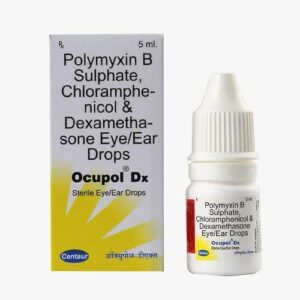CHLORAMPHENICOL + DEXAMETHASONE + POLYMYXIN-B
Chloramphenicol: Chloramphenicol is an antibiotic drug that is commonly used for the treatment of bacterial infections. It is effective against a wide range of gram-positive and gram-negative bacteria.
The mechanism of action of chloramphenicol is by inhibiting bacterial protein synthesis. It binds to the bacterial ribosome, specifically to the 50S subunit, and blocks the peptidyl transferase activity. This prevents the formation of peptide bonds between amino acids during protein synthesis, leading to the inhibition of bacterial growth.
Chloramphenicol is available in various formulations including oral capsules, injectable solutions, and topical ointments. The specific dose and duration of treatment depend on the type and severity of the infection being treated. It is important to follow the prescribed instructions from a healthcare professional.
While chloramphenicol is generally well-tolerated, it can have several potential side effects. Common side effects include gastrointestinal disturbances such as nausea, vomiting, and diarrhea. It can also cause bone marrow suppression, resulting in a decrease in red and white blood cells, leading to anemia and an increased risk of infection. This is more common with higher doses and prolonged treatment duration. Rare but serious side effects include a condition called gray baby syndrome, which is more likely to occur in premature infants due to their inability to properly metabolize chloramphenicol.
Chloramphenicol should be used with caution and under the guidance of a healthcare professional. It is important to report any side effects or adverse reactions promptly to ensure appropriate management.
Dexamethasone: Dexamethasone is a corticosteroid medication that is used to treat various conditions such as allergic reactions, inflammation, autoimmune disorders, and certain types of cancers. It belongs to a class of drugs known as glucocorticoids.
The mechanism of action of dexamethasone involves its binding to corticosteroid receptors within cells. This binding leads to the activation of anti-inflammatory and immunosuppressive effects. It is believed to inhibit the production of enzymes responsible for inflammation and reduce the activity of immune cells involved in the inflammatory response.
The dosages of dexamethasone vary depending on the condition being treated. It is available in different forms, including tablets, injections, and eye drops. The exact dose and duration of treatment should be determined by a healthcare professional.
Like any medication, dexamethasone can cause side effects. The most common side effects include increased appetite, weight gain, fluid retention, insomnia, mood changes, increased blood sugar levels, and gastrointestinal disturbances.
Other less common but more serious side effects may include blood disorders, osteoporosis (weakening of bones), increased susceptibility to infection, and adrenal suppression. Long-term use of dexamethasone at high doses may also increase the risk of developing certain conditions such as diabetes, hypertension, or cataracts.
It is important to follow the prescribed dosage and duration of treatment as directed by a healthcare professional. Abruptly stopping or reducing the dose without medical guidance can lead to withdrawal symptoms.
It’s important to note that dexamethasone should not be used without a prescription and medical supervision, as it is a potent drug with potential side effects. Consult with a healthcare professional for more information on the use of dexamethasone.
Polymyxin-B: Polymyxin-B is an antibiotic drug that is primarily used to treat bacterial infections. It belongs to the class of drugs known as polymyxins, which are effective against a wide range of gram-negative bacteria, including certain strains of Pseudomonas aeruginosa.
The mechanism of action of Polymyxin-B involves binding to the bacterial cell membrane and disrupting its integrity. This disrupts the permeability barrier of the bacteria, leading to leakage of intracellular components and eventual cell death.
Polymyxin-B can be administered topically as an ointment or solution for skin infections or eye infections. It can also be given intravenously for more serious infections, such as urinary tract infections, pneumonia, or sepsis.
The dosage of Polymyxin-B varies depending on the severity of the infection and the patient’s age and weight. For topical use, a thin layer of the ointment or a few drops of the solution should be applied to the affected area several times a day. For intravenous administration, the dosage is typically calculated based on body weight and administered every 8-12 hours.
As with any medication, Polymyxin-B may cause side effects. The most common side effects include local irritation, redness, and itching at the site of application for topical use. Systemic use of the drug can lead to more severe side effects, including kidney damage, neurotoxicity, and muscle weakness. Patients with pre-existing kidney problems or those taking other medications that are known to cause kidney damage should be closely monitored when using Polymyxin-B.
It is important to note that Polymyxin-B should only be used under the guidance and prescription of a healthcare professional, as improper use or overuse of antibiotics can lead to antibiotic resistance and other complications.

